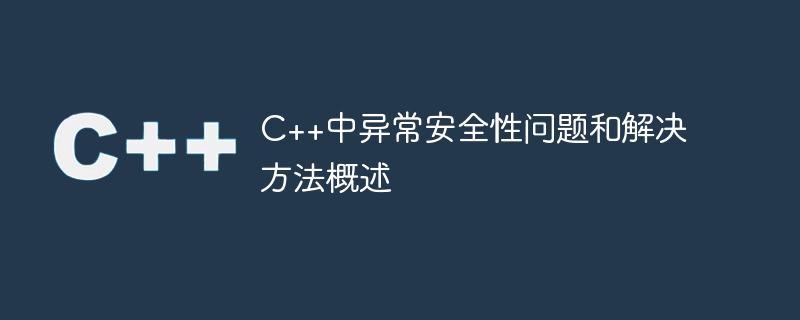

Overview of exception safety issues and solutions in C
Introduction:
Exception safety means that when an exception occurs in the program, it can ensure that the allocated Resources are released correctly to avoid memory leaks and object state inconsistencies. In C programming, exception safety is a very important concept that can improve the reliability and stability of the program. This article will provide an overview of common exception safety issues in C and their solutions, and provide specific code examples.
1.1 Basic exception safety issues
Basic exception safety requirements mean that when an exception occurs in the program, there will be no memory leaks. In other words, allocated resources should be released correctly. For example, if the program throws an exception during dynamic memory allocation, the delete operator must be used to release the allocated memory.
Sample code 1: Basic exception safety issues
void allocateMemory() { int* p = new int; throw std::runtime_error("Exception"); delete p; }
In the above code, when an exception is thrown, the delete p statement will not be executed, causing a memory leak. To solve this problem, we can use smart pointers to manage dynamic memory to ensure that resources can be safely released in the event of an exception.
Sample code 2: Use smart pointers to achieve basic exception safety
void allocateMemory() { std::unique_ptr p(new int); throw std::runtime_error("Exception"); }
Use std::unique_ptr to manage dynamic memory allocation, no longer need to manually call delete, ensuring that when an exception is thrown The resources will be released correctly.
1.2 Strong exception safety issues
Strong exception safety requires that in addition to ensuring basic exception safety, it must also ensure that the program state will not be affected by exceptions. In the event of an exception, the program should be rolled back to the original state to ensure data consistency. In order to achieve strong exception safety, transactional programming techniques can be used, that is, exception handling blocks are used to implement error handling.
Sample code 3: Strong exception security issues
class Database { public: void updateData(int newData) { // 创建一个事务 Transaction t(this); // 更新数据 m_data = newData; // 模拟数据库写入错误 throw std::runtime_error("Database write error"); // 提交事务 t.commit(); } private: int m_data; }; class Transaction { public: Transaction(Database* db) : m_db(db), m_committed(false) {} ~Transaction() { if (!m_committed) { // 回滚操作 m_db->rollback(); } } void commit() { // 提交事务 m_committed = true; } private: Database* m_db; bool m_committed; };
In the above code, the database class Database provides the updateData function to update data. When using transactional programming, when an exception occurs, the destructor of the Transaction class will roll back the database operation to ensure data consistency.
1.3 The problem of not throwing exceptions
In C, the operations of the move constructor and move assignment operator can throw exceptions. When a move operation fails, the object's state may become inconsistent, which is an unacceptable situation. To avoid this problem, you can use noexcept to declare move operations that do not throw exceptions.
Sample code 4: The problem of not throwing exceptions
class MyVector { public: MyVector(size_t size) : m_data(new int[size]) {} MyVector(MyVector&& other) noexcept : m_data(other.m_data) { other.m_data = nullptr; } MyVector& operator=(MyVector&& other) noexcept { if (this != &other) { delete[] m_data; m_data = other.m_data; other.m_data = nullptr; } return *this; } ~MyVector() { delete[] m_data; } private: int* m_data; };
In the above code, the MyVector class implements the move constructor and move assignment operator. By using the noexcept keyword, you ensure that the move operation does not throw an exception, thereby ensuring the consistency of the object state.
The above is the detailed content of An overview of exception safety issues and solutions in C++. For more information, please follow other related articles on the PHP Chinese website!
 What are the differences between c++ and c language
What are the differences between c++ and c language Recommended learning order for c++ and python
Recommended learning order for c++ and python Cost-effectiveness analysis of learning python and c++
Cost-effectiveness analysis of learning python and c++ Is c language the same as c++?
Is c language the same as c++? Which is better to learn first, c language or c++?
Which is better to learn first, c language or c++? The difference and connection between c language and c++
The difference and connection between c language and c++ C++ software Chinese change tutorial
C++ software Chinese change tutorial Cost-effectiveness analysis of learning python, java and c++
Cost-effectiveness analysis of learning python, java and c++



